Physical Address
304 North Cardinal St.
Dorchester Center, MA 02124
More than 200 distinct operations are performed in the ankle and foot. Indications for operative intervention include traumatic, overuse, degenerative, arthritic, congenital, neoplastic, and inflammatory conditions. Procedures unique to the foot and ankle are reviewed here, with emphasis on the imaging techniques used to evaluate successful and complicated operations.
The most commonly performed operations in the foot and ankle—fracture treatment, osteotomies, and arthrodeses—are designed to fuse bones. After proper positioning of the bones or bone fragments (and preparation of the bone surfaces, in the case of nonunion repair or arthrodesis), the surgeon will use some form of fixation to maintain alignment while healing occurs. Internal, metallic implants are most commonly used for this purpose, and their presence affects the selection and interpretation of postoperative imaging studies.
The indications and principles of fracture fixation in the foot and ankle are the same as those in the rest of the appendicular skeleton (see Chapter 106 ). The goal is to restore the normal anatomic position of the fragments by either closed or open reduction and then to maintain the fragment position until healing can occur. Simple casting or splinting combined with non-weight bearing will suffice for most stable fractures, whereas internal fixation is desirable for inherently unstable or intraarticular fractures. Established nonunions also require freshening of the fractured bone ends and bone grafting. Internal fixation is contraindicated in the presence of ongoing infection, severe comminution, and deficient soft tissue coverage and during the acute phase of neuropathic disease. In these instances, an external fixator can provide fragment stability while healing progresses.
Osteotomies are performed to correct malalignments. The surgeon cuts the bone with an osteotome and then reassembles the pieces to correct any length, angulation, position, or rotational abnormality. Internal fixation with or without bone grafting then allows the bone to heal in its new orientation ( Fig. 111-1A ). Common indications for hindfoot and midfoot osteotomies include cavus, planus, equinus, varus, valgus, adductus, and abductus deformities due to neuromuscular, traumatic, degenerative, and arthritic causes, as well as complex malalignments due to congenital conditions. Forefoot osteotomies may be combined with fusions or soft tissue procedures for malalignments of the great toe (e.g., hallux valgus, metatarsus primum varus) and lesser toes (e.g., bunionette, cock-up, claw, hammer, and crossover deformities).

Arthrodesis is surgical fusion of a joint, usually performed for severe arthritis and pain unresponsive to nonsurgical treatment. The most common causes in the foot and ankle are posttraumatic osteoarthritis and rheumatoid arthritis. Arthrodesis alone, or in addition to a soft tissue operation, is often indicated to restore and maintain plantigrade alignment in a variety of congenital and acquired conditions. A common example is hindfoot triple arthrodesis (surgical fusion of the subtalar, talonavicular, and calcaneocuboid joints) when severe planovalgus results from end-stage posterior tibial tendon dysfunction.
To fuse a joint, the surgeon must first decorticate the apposing bone surfaces, exposing the subchondral bone. Bone graft serves as scaffolding for new bone growth and as a source of growth factors and osteoprogenitor material. Finally, compressive fixation is applied with internal, or less commonly, external fixation. Newer surgical techniques now allow the surgeon to perform selected fusions arthroscopically. The contraindications to attempting an arthrodesis are the same as those for internal fixation of fractures and osteotomies.
Radiographs usually suffice after surgical treatment of ankle and foot fracture fixation, osteotomies, and/or arthrodeses (see Fig. 111-1 ). Progressive blurring and narrowing of the interface between opposing bone surfaces indicate healing by callus formation or by incorporation of bone graft. Successful fusion establishes continuity of mature trabeculae and/or cortex between the bones or bone fragments. Obliteration of the space between the bones by itself does not indicate fusion, because with rigid internal fixation, the bone surfaces will often be in full contact immediately after the procedure. Sequential examination is often required to fully document full osseous incorporation and healing. How much mature bony bridging is necessary for surgical success is not known, but, often, as little as 20% will translate into clinical success, which is defined by (1) lack of pain and tenderness at the operative site, (2) absence of motion between the bones under stress, and (3) ability to function (bear weight). When evaluating postoperative alignment in addition to the completeness of fusion, standing radiographs are needed.
When extensive callus formation, bone graft, or metal implants obscure the plane between the bones, multidetector CT examination is the study of choice to evaluate healing. To minimize streak artifact from internal fixation, relatively high kilovolts peak (typically 140 kVp), thin-section collimation (1 mm or less), and a soft reconstruction kernel are useful. Direct scanning perpendicular to the joint or osteotomy is ideal, but multiplanar reformatted images in the required planes will usually be diagnostic. Last, including the contralateral foot and ankle in the CT images often provides a baseline reference for the normal anatomy and alignment. On CT images, complete fusion appears as mature bridging trabeculae and/or cortex across the operative bed ( Fig. 111-2 ); in earlier stages of healing, indistinct callus and bone graft between the bones will progressively increase in amount and attenuation before bridging the gap.
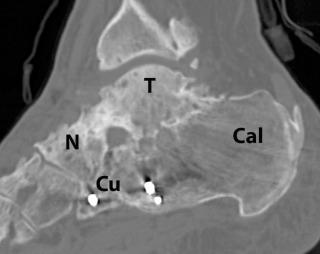
MRI is not a primary modality for the routine assessment of osteosynthesis operations, but, because these procedures are common, an arthrodesis or osteotomy site will often be present on MR examinations performed for other foot and ankle soft tissue conditions. During the healing phase, marrow edema will be present in the bones adjacent to the operation site, representing a combination of mechanical trauma from the procedure and granulation tissue. Similar to the case for radiographs and CT, continuity of mature bone (represented by continuity of the marrow fat) indicates fusion (see eFig. 111-1 ), although mild surrounding marrow edema may persist even after fusion occurs, because of ongoing bone remodeling.
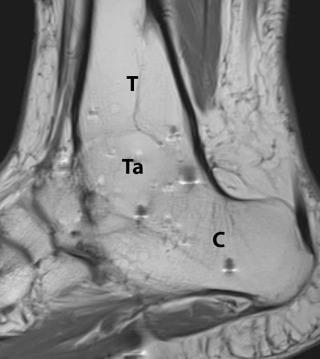
For osteotomies and arthrodesis procedures, healing of the bone graft harvest site should also be evaluated. The distal tibia or calcaneus may be used as a source of bone graft for foot and ankle procedures. Periosteal callus around cortical windows and gradual filling-in of the lytic defect radiographically indicate healing of the donor site. The harvest site often fills with primarily fatty marrow, which is recognized by its paucity of trabeculae and lipid content on CT and MRI. Before complete healing, these are areas of relative weakness, which may be exacerbated because of disuse. During this stage, insufficiency fractures through the donor site are important sources of morbidity.
After incisional morbidity (e.g., wound infection, dehiscence, traumatic neuroma), nonunion is the most common complication of attempted osteosynthesis. Nonunion means that healing stops before solid bone fusion occurs. The risk of nonunion relates to the integrity of the surgical bed (surrounding infection, tissue ischemia, and a deficient soft tissue envelope all tend to inhibit bone production), the quality of the bone (osteoporotic bone and bone compromised by prior nonunion, osteonecrosis, osteomyelitis, radiation, tumor, or Paget disease take longer to heal), the adequacy of the surgical reduction and fixation, and host factors, such as cigarette smoking, diabetes, and obesity. Radiographically, motion between the bone fragments from one examination to the next, often accompanied by loose or fractured implants, is diagnostic of nonunion (see Fig. 111-1C ). When signs of motion are lacking, progressive resorption of bone graft, a persistent gap between the bone surfaces, and lack of osseous bridging each suggests nonunion but neocortex formation along the bone ends is diagnostic. On CT examination, the findings of nonunion are often easier to recognize without obscuration by overlying structures (see Fig. 111-1D ).
When there is lack of bridging bone, but new cortex has not formed, it may be unclear whether delayed union or nonunion is present. In those circumstances, simply noting that the site is ununited and obtaining a short-term follow-up examination may be necessary. On MRI, distinguishing nonunion from delayed union is difficult; however, identification of a synovial pseudoarticulation containing fluid and lined by a capsule indicates nonunion.
Whereas delayed union may be managed nonoperatively (by casting, decreased weight bearing, or electrical stimulation), symptomatic nonunion typically requires repeat operation. For small, noncritical locations, excision of the nonunited fragment may be curative. In most cases, however, a revision of the operation, including removal of prior implants, decortication of the bone surfaces, application of fresh bone graft with or without bone-stimulating factors, and reapplication of new internal fixation, is needed. Extending the surgery to include fusion of surrounding joints may be necessary if postoperative instability contributed to the original nonunion. The risk of recurrent nonunion increases with each operation.
Other complications manifest on imaging studies just as they would in the absence of a prior procedure. These include osteomyelitis, residual or recurrent deformity, accelerated osteoarthritis at adjacent joints, osteonecrosis, and stress fractures. Arthrodesis may accelerate the development of osteoarthritis in adjacent joints; however, radiographic demonstration of osteoarthritis, in these cases, does not necessarily equate with a poor outcome or patient satisfaction. Implants may become symptomatic because of impingement on adjacent structures or intraarticular extension. If the location of an orthopedic implant is not clear radiographically, CT examination can easily depict its course. Symptomatic devices can be removed after osseous fusion has occurred.
Total ankle replacement (TAR) is an alternative to ankle arthrodesis for management of refractory pain resulting from end-stage arthritis. In this procedure, a two-component or three-component metallic prosthesis with a polyethylene bearing replaces the tibiotalar joint. Unlike ankle arthrodesis, TAR preserves ankle range of motion for active patients and avoids the high incidence of hindfoot osteoarthritis seen after ankle fusion while offering equivalent pain relief. Newer-generation ankle arthroplasties have demonstrated good intermediate-term results, with implant survivorship rates of 70% to 98% at 3 to 6 years.
TAR is performed in patients with end-stage ankle osteoarthritis resulting from traumatic, infectious, inflammatory, degenerative, and congenital disorders, causing pain refractory to nonoperative therapy, including rest, nonsteroidal anti-inflammatory drugs, orthoses, and corticosteroid injections. The optimal patient for TAR is older (>50), thin, and has low functional demands, whereas patients who are younger, more active, and obese have poorer outcomes with TAR and fare better with arthrodesis. Contraindications include active infection, neuropathy, talar osteonecrosis, overlying soft-tissue deficiency, severe peripheral vascular disease, and poor bone stock. Although not an absolute contraindication, coronal or sagittal plane deformity of the ankle exceeding 15 degrees may increase the difficulty of TAR and require additional procedures to ensure optimal implant position.
Preoperative weight-bearing anteroposterior and lateral radiographs to establish the relationship of the ankle to the mechanical axis of the limb and CT to assess bone stock quality are often useful for surgical planning. The ankle and subtalar joints are intricately related, so that if foot malalignment is also present, additional procedures may be necessary to achieve a plantigrade foot, which is vital to the functional outcome of total ankle replacement (TAR). Medial soft tissue release, lateral ligament reconstruction, and tibial osteotomy for rotational or angular deformity are performed as needed to optimize component positioning.
After preparing the surfaces of the tibial plafond and talar dome by removing 3 to 5 mm of subchondral bone with a saw, the surgeon anchors porous, ingrowth tibial, and talar metallic components in bone using fixation with a variety of pegs, posts, keels, and flanges. In two-component TAR, the polyethylene liner is attached to the tibial tray, whereas three-component arthroplasties feature a mobile liner ( Fig. 111-3 ). Syndesmotic arthrodesis is performed with some systems for further stabilization of the tibial tray by allowing load sharing through the fibula ( Fig. 111-4 ). Because fracture of the medial or lateral malleolus may occur during performance of the tibial osteotomy or from placement of an oversized tibial component, some surgeons perform prophylactic screw fixation of the malleoli at the time of component implantation. Distal fibular osteotomy is sometimes performed to correct alignment abnormalities or for access to the ankle joint at the time of ankle replacement.
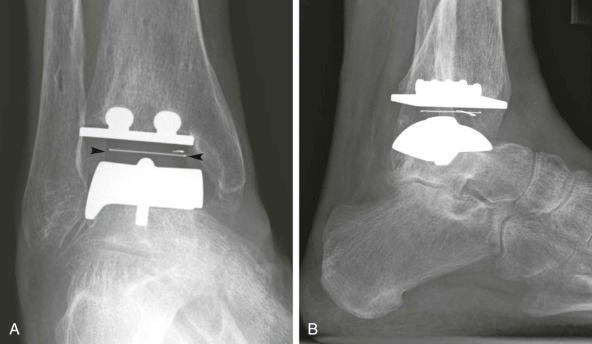
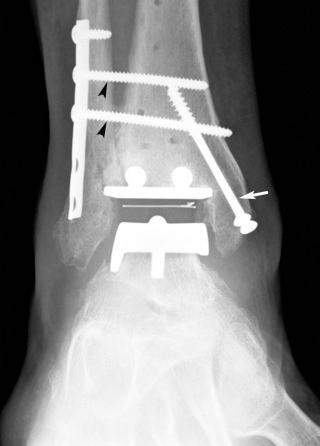
Weight-bearing ankle radiographs are routinely obtained at each postoperative visit to assess for proper alignment of the tibial and talar components, according to established criteria. The tibial component should be positioned perpendicularly to the long axis of the tibia, and the articular surfaces of the talar and tibial components should be parallel. A properly sized tibial tray extends from the anterior to the posterior cortical margin of the plafond. Radiodense markers indicate the location of the polyethylene liner and are useful to identify a malpositioned liner. Comparison of serial radiographs—including the initial postoperative views—is essential to identify complications. CT provides additional detailed information on the status of the subchondral bone and allows direct visualization of the polyethylene liner. The roles of MRI, ultrasound, and scintigraphy for imaging TAR have not been defined in the literature.
Intraoperative complications of TAR include neurovascular injury (the superficial peroneal nerve is at particular risk) and malleolar fracture. Postoperative complications include edge loading, osteolysis, implant loosening, fracture or migration of the polyethylene bearing, heterotopic ossification, infection, and fracture. Edge loading ( Fig. 111-5 ) leads to asymmetric polyethylene liner wear, which manifests on radiographs as nonuniform narrowing of the medial or lateral joint space. As in larger joint arthroplasties like the hip, osteolysis after TAR demonstrates scalloped erosions, which undermine the tibial and/or talar components due to a histiocyte-mediated foreign body reaction ( Fig. 111-6B ). Loosening of the implants is diagnosed when component migration occurs on serial radiographs, and imaging typically shows bone resorption around the mobile implant (see eFig. 111-2 ). Subluxation or dislocation of a mobile polyethylene bearing may occur in three-component TAR. Pain in the medial gutter has been associated with medial bone spurs, and lateral malposition of the arthroplasty components may result in talofibular abutment and pain. Early or late postoperative infection presents with a painful and erythematous ankle and elevated inflammatory markers. Radiographic findings include soft tissue swelling and bone resorption (see eFig. 111-3AB ). Indium-111-labeled white blood cell (WBC) imaging is useful to document the presence of infection, which manifests as a focal area of increased WBC activity around the implant (see eFig. 111-3C ).
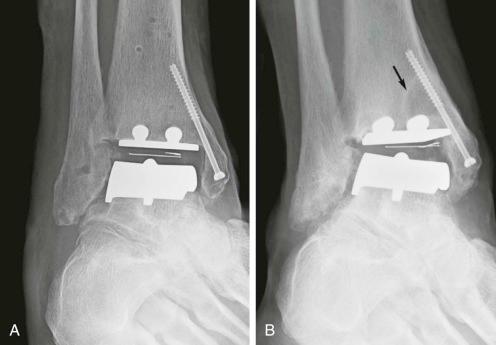
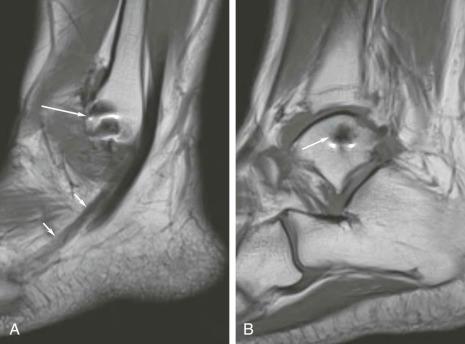

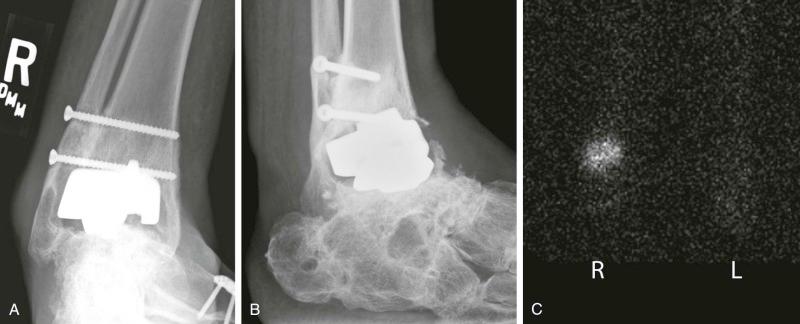
The term arthroereisis refers to limitation (but not elimination) of motion at a joint with abnormal mobility. Subtalar arthroereisis involves the placement of an implant—most often a metallic or bioabsorbable interference screw—in the sinus tarsi.
Become a Clinical Tree membership for Full access and enjoy Unlimited articles
If you are a member. Log in here